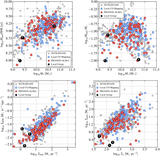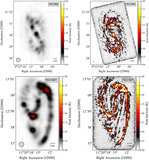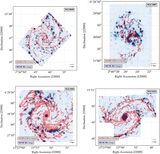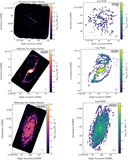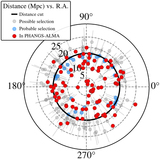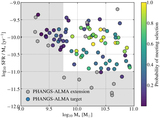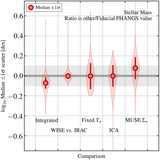Image Details

Caption: Figure 15.
Comparisons between CO(2–1) measurements from PHANGS–ALMA and previous IRAM 30 m CO(2–1) mapping. All four panels compare measurements from our CO(2−1) data to CO(2−1) observations targeting the same galaxies using the HERA array receiver on the IRAM 30 m telescope (from HERACLES and follow-up work; Leroy et al. 2009, 2013b, and A. Schruba et al. 2021, in preparation). The top left panel compares integrated fluxes; in this figure we have applied our WISE3-based aperture correction to our PHANGS measurements. The bottom left panel compares line-integrated intensity between the two data sets at 17″ resolution. The right-hand panels show ratios between the two data sets; the top right one for galaxy-integrated ratios and the bottom right one for pixel-by-pixel ratios. Overall the agreement is good. The median galaxy-integrated ratio is 0.97 (−0.01 dex) with 0.057 dex, or about 14%, galaxy-to-galaxy scatter. We mark four strong outliers, listed in the text. The median pixel-wise ratio is 0.92 (0.037 dex) with 0.11 dex, or about 29%, scatter. The model shown in the bottom panel includes the measured statistical uncertainty and adopts a 20% gain uncertainty. We attribute most of the nonstatistical scatter to gain uncertainties associated with the IRAM 30 m observations, though formally these represent only relative calibration and image construction uncertainties.
Copyright and Terms & Conditions
© 2021. The American Astronomical Society. All rights reserved.


